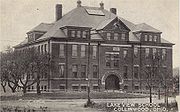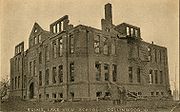
Collinwood School Fire
Encyclopedia


Ash Wednesday
Ash Wednesday, in the calendar of Western Christianity, is the first day of Lent and occurs 46 days before Easter. It is a moveable fast, falling on a different date each year because it is dependent on the date of Easter...
, March 4, 1908, was one of the deadliest disasters of its type in the United States
United States
The United States of America is a federal constitutional republic comprising fifty states and a federal district...
. 172 students, two teachers and a rescuer were killed in the conflagration
Conflagration
A conflagration or a blaze is an uncontrolled burning that threatens human life, health, or property. A conflagration can be accidentally begun, naturally caused , or intentionally created . Arson can be accomplished for the purpose of sabotage or diversion, and also can be the consequence of...
in Collinwood, Ohio
Ohio
Ohio is a Midwestern state in the United States. The 34th largest state by area in the U.S.,it is the 7th‑most populous with over 11.5 million residents, containing several major American cities and seven metropolitan areas with populations of 500,000 or more.The state's capital is Columbus...
, a community that has since been absorbed into the city of Cleveland
Cleveland, Ohio
Cleveland is a city in the U.S. state of Ohio and is the county seat of Cuyahoga County, the most populous county in the state. The city is located in northeastern Ohio on the southern shore of Lake Erie, approximately west of the Pennsylvania border...
.
While the Lake View School was built with load-bearing masonry outer walls, much of the four story building's floor structure system used wooden joist
Joist
A joist, in architecture and engineering, is one of the horizontal supporting members that run from wall to wall, wall to beam, or beam to beam to support a ceiling, roof, or floor. It may be made of wood, steel, or concrete. Typically, a beam is bigger than, and is thus distinguished from, a joist...
s. It was one wooden joist that caught fire when it was overheated by a steam pipe
Steam pipe
Steam pipe may refer to:* The steam pipe of a steam locomotive passes the steam from the boiler to the cylinders.* District heating, a system for distributing heat.** New York City steam system, a district heating system in New York City....
. The building’s main stair case extended from the front doors of the building, up to the third floor; without benefit of fire doors. The stairwell acted like a chimney, helping to spread the fire quickly. Oiled wooden hall and classroom floors also fueled the fire.
A common misconception about the building's design is that the doors opened inward. They did not, as has been verified in accounts of the fire written at the time. Doors to the building were equipped with common door knob latches, not the more modern crash bar
Crash bar
A crash bar is a mechanism for unlatching a door, consisting of a spring-loaded metal bar fixed horizontally to the front of the door and hinged...
type latch. As panic leading to the crush of a large number of students in stairwell vestibules contributed to the death toll, students also died as a result of smoke inhalation and the fire itself. Some children died jumping from second- and third-story windows. Community members watched as victims trapped in the building were burned beyond recognition.
Aftermath

Mass grave
A mass grave is a grave containing multiple number of human corpses, which may or may not be identified prior to burial. There is no strict definition of the minimum number of bodies required to constitute a mass grave, although the United Nations defines a mass grave as a burial site which...
in Cleveland's Lake View Cemetery
Lake View Cemetery
Lake View Cemetery is located on the east side of the City of Cleveland, Ohio, along the East Cleveland and Cleveland Heights borders. There are over 104,000 people buried at Lake View, with more than 700 burials each year. There are remaining for future development. Known locally as "Cleveland's...
. Additionally, several families who lost their children in the fire chose to bury their children's remains adjacent to the Collinwood victims.
Following the fire, the remains of the Lake View School were demolished and a memorial garden planned for the site. A new school—Collinwood Memorial Elementary School—was built adjacent to the disaster site, and incorporated many features that had been lacking in the previous building. Unlike the building involved in the disaster, the new school incorporated fire safe stairwells, a central alarm system, and was built of steel framing and other fire-safe materials. Although the new school was torn down in 2004, a memorial plaque remains on the site as new development is added to the area.
The disaster also led to a national effort to change doors at public buildings so that they opened outward. It was thought about after the Iroquois Theatre Fire. They also made "panic bar" latches on doors required in all schools. The final casualty of the fire was the independence of the Collinwood community itself. Unable to sufficiently guarantee fire safety resources for its residents, voters approved an annexation of Collinwood into Cleveland within two years of the fire.
Further reading
Bellamy, John Stark II (1997). Maniac in the Bushes: More Tales of Cleveland Woe. Cleveland, OH: Gray & Company, Publishers. ISBN 978-1-886228-19-1External links
- Encyclopedia of Cleveland entry: Collinwood School Fire
- Dead Ohio Collinwood School Fire
- Collinwood Fire Memorial Sculpture, Lakeview Cemetery
- Sun Newspaper’s 90th anniversary coverage
- Cleveland Plain Dealer's 100th anniversary coverage
- New Memorial School built on the premises of Lakeview/ Old Memorial School.
- Collingwood School Memorial at Findagrave
- Ash Wednesday at Making Light

